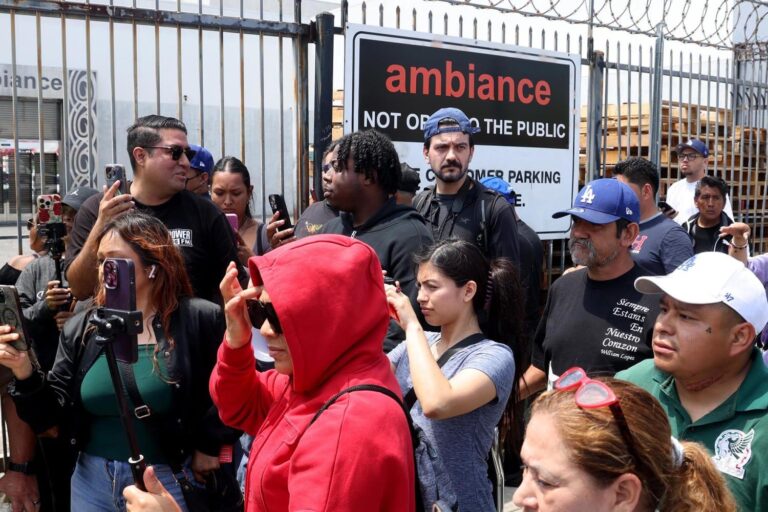Aftermath of Ambiance Apparel Raid: Navigating Uncertainty in Los Angeles’ Fashion District
Community Reeling from Ambiance Apparel Enforcement Action
The recent crackdown on Ambiance Apparel has sent shockwaves through Los Angeles’ Fashion District, a vital center for the city’s garment industry. Business owners and employees alike are now facing a wave of uncertainty as the raid disrupts established supply chains and raises concerns about the future stability of their operations. Vendors reliant on Ambiance Apparel’s network are experiencing immediate interruptions, which could lead to delays in product availability and financial strain.
Local entrepreneurs worry that this incident may usher in a new era of intensified inspections and regulatory oversight, potentially altering the open-market dynamics that have long fueled the district’s creative and economic vitality. Industry experts highlight the fragile equilibrium between enforcing legal compliance and nurturing the innovative spirit that defines the Fashion District’s success.
Among the primary concerns voiced by stakeholders are:
- Disruptions in inventory flow threatening timely merchandise delivery
- Job insecurity for thousands employed in garment production and distribution
- Rising operational expenses due to stricter compliance requirements
- Potential damage to the district’s reputation that could deter future investments
| Area Affected | Immediate Issue | Possible Mitigation |
|---|---|---|
| Supply Chain | Interrupted shipments | Identifying alternative suppliers |
| Labor Force | Employment instability | Union engagement and workforce retraining |
| Regulatory Compliance | Heightened oversight | Enhanced staff training on legal standards |
| Business Climate | Investor reluctance | Strengthening community-business-government partnerships |
Small Enterprises Face Challenges Amid Escalating Enforcement
Following the Ambiance Apparel raid, many small-scale business owners and their employees in the Fashion District are navigating a landscape fraught with anxiety. These small enterprises, which form the backbone of the district’s economy, are especially vulnerable to the unpredictability of increased regulatory scrutiny. Owners express apprehension about compliance complexities and the potential for operational disruptions without clear guidance or support.
Key difficulties highlighted include:
- Ambiguity surrounding the extent of enforcement and future regulatory applications
- Financial burdens stemming from possible penalties or required operational changes
- Worker stress due to fears over job stability amid the crackdown
| Focus Area | Business Concerns | Employee Perspectives |
|---|---|---|
| Regulatory Compliance | Demand for transparent legal advice | Apprehension about sudden unemployment |
| Financial Impact | Risk of fines and costly adjustments | Fear of reduced hours or layoffs |
| Community Stability | Threat of business closures weakening local economy | Morale decline affecting productivity |
Employee Concerns: Job Security and Immigration Status Under Threat
The immigration-focused enforcement targeting Ambiance Apparel has intensified fears among workers, many of whom are immigrants, about their job security and legal standing.This has created a pervasive atmosphere of anxiety throughout the Fashion District, with employees worried that any interaction with authorities or mistaken affiliations could jeopardize their employment and residency.
Workers report a climate of fear that extends beyond individual companies, impacting the broader community. Their main concerns include:
- Unexpected job termination without prior notice or severance packages
- Possibility of detention or deportation following immigration status investigations
- Reluctance to communicate with employers or government officials
- Increased psychological stress affecting mental well-being and work performance
| Worker Concern | Consequences |
|---|---|
| Employment Stability | Financial hardship due to sudden job loss |
| Immigration Status | Legal risks including deportation proceedings |
| Community Relations | Deterioration of trust within workplaces and neighborhoods |
| Mental Health | Elevated anxiety and stress symptoms |
Advocating for Clear Policies and Support to Safeguard the Workforce
Business leaders and employees in the Fashion District are calling on city officials and policymakers to implement transparent regulations and robust support systems that protect the community’s workforce. The recent enforcement actions, including the Ambiance Apparel raid, have fostered an habitat of instability and economic uncertainty. Advocates stress the importance of balanced reforms that uphold workers’ rights while minimizing harm to small businesses.
- Calls for open dialog from law enforcement and regulatory agencies
- Introduction of labor protections tailored to the apparel and fashion sectors
- Creation of accessible resources providing legal, financial, and social assistance
- Establishment of collaborative platforms involving businesses, workers, and government representatives to address ongoing concerns
Experts warn that without these interventions, the district risks losing its competitive advantage and the essential workforce that sustains its economy. A recent analysis underscores the urgency for coordinated efforts:
| Challenge | Current Effect | Recommended Action |
|---|---|---|
| Job Security | Rising layoffs and fear of enforcement raids | Legal safeguards and emergency support programs |
| Regulatory Compliance | Confusing and inconsistent rules | Clear guidelines and frequent updates |
| Community Trust | Distrust toward enforcement agencies | Facilitated dialogues and mediation efforts |
Conclusion: Seeking Stability Amidst Uncertainty
The repercussions of the Ambiance Apparel raid continue to ripple through Los Angeles’ Fashion District, leaving businesses and workers in a state of apprehension. Many fear that ongoing enforcement actions could undermine the livelihoods of thousands and erode the district’s historic vibrancy as a garment manufacturing hub. As the community awaits clearer policies and support, the hope remains that collaborative solutions will restore confidence and stability to this cornerstone of the city’s economy.




